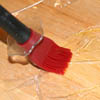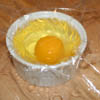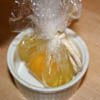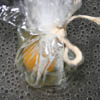What are best methods to poach an egg?
Before we discuss the best methods that produce what many refer to as "the perfect poached egg", it is important to discuss the properties that affect both the egg white and egg yolk since a perfect poached egg consists of a runny egg yolk and firm but not chewy egg white.
IMPORTANT TEMPERATURES FOR COOKING EGGS
145°F/63°C -- Egg whites begin to thicken (cogulation begins)
150°F/ 65°C--Egg whites become a tender solid although ovomucin yolk cords will coagulate much higher. The yolk protein starts to thicken.
158°F/70°C-- Egg yolks set.
165°F/73°C-- Whole egg sets. If eggs are cooked at 212F for too long they will get rubbery as proteins continue to coagulate and "water is pushed out from between protein molecules".
180°F/80C - Ovalbumin begins to set at while Ovotransferrin only begins to set when heated to 140°F/60C.
NOTES: Egg white contains approximately 40 different proteins with Ovalbumin (54%), and Ovotransferrin 12% being the major components. Egg yolks contain lipoproteins which coagulate at about 158°F. If eggs are cooked at 212°F for too long they will just get rubbery as proteins continue to coagulate and water gets pushed out from between protein molecules. Keep in mind salmonella is killed instantly when subjected to a temperature of 165° F.
HOW FRESH IS YOUR EGG
One of the most important factors in cooking a perfect poached egg is freshness. In a fresh egg the egg white is firm. Older eggs have runny whites and will not yield a well formed poached egg. The easiest way to tell how fresh an egg is by checking the Julian date located on the side of the egg box. These are the 3 number codes that run between 001 -365 .. 001 is January 1st. The number is usually next to the expiration date.
Why do older eggs get runny? While it is possible for some fresh eggs to be runny, this is usually a sign of an old egg (see How fresh is that egg) It is the liquid white that produces irregular edges in poached eggs.The egg white of a very fresh egg is cloudy because of the presence of dissolved carbon dioxide As an egg ages, the egg - and especially the white - becomes more alkaline as carbon dioxide and moisture is released from the egg through pores in the shell and is replaced by air. Since the thick albumen is the result of the linkage between egg white proteins ovomucin and lysozyme, which is most stable at pH 7.5 increasing pH results in destabilizing the linkage. Ovomucin and lysozyme then dissolve and the egg albumen turns to liquid. The proteins are still however in the folded state. |
BEST EGG POACHING METHODS
1) How to Poach and Egg Using Plastic Wrap
This method insures a perfect poached egg every time and has an interesting advantage that herbs and flavored oil can be added inside the wrap to give the egg a unique flavor. In addition there is no excess egg white that is discarded in other methods.
|
|
|
|
||||
STEP 1 |
STEP 2 |
STEP 3 |
STEP 4 |
Bring a pot of water to a simmer the temperature should be 180F.
1) Brush some oil or fat on one side of a piece of plastic wrap, and then insert the plastic wrap inside of a mold or a small cup. You can brush with duck fat, olive oil or use or butter.
2) Carefully break the egg into the plastic wrapped mold. You can add a few drops of truffle oil here for an added dimension.
3) Close the film with a piece of string. A loose mold will form a smoother egg; a tighter wrap will give a patterned appearance to the cooked egg.
4) Drop (or hang) the plastic wrap into the simmering water and cook 4-6 minutes till top white is set and yolk is still runny.
5) Pull the wrapper out of the pot and carefully cut the plastic wrap removing the egg.
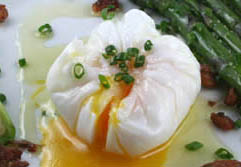 |
The image on the left shows a duck egg that was poached using plastic saran wrap and cooked for 4-5 minutes. |
2) How to Poach an Egg (Heston Blumenthal Method)
Heston Blumenthal is an English celebrity chef and owner of The Fat Duck, a three-Michelin-starred restaurant in Bray, Berkshire, which has been voted Best Restaurant in the UK and received a perfect score of 10/10 every year since 2007 by The Good Food Guide.
First it is important to use the freshest eggs you can. This provides the largest proportion of thick white (least amount of liquid white) and will allow the least amount of spread. As stated in Harold McGee's book "On Food and Cooking", adding vinegar and salt "does speed coagulation, but also produces shreds and an irregular film over the egg surface").
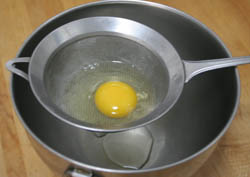 |
We put AN egg into A fine mesh and let it sit for 5 minutes to drain the excess liquid egg white from the outer albumen section. This is the part that usually gives the shreds of egg white during poaching. The fresher the egg, the less liquid will drain. |
As mentioned by McGee, Heston Blumenthal uses the simple trick of removing the runny white from the poached egg before it is cooked using a fine mesh strainer or a perforated spoon.Note: (This runny part of the egg is the thin outer part of the white that requires much higher temperatures to set). The strainer can then be used to slowly slide the egg into the simmering water. The egg is cooked at 80C for 4 minutes.
From Heston Blumenthal:
1. Fill a saucepan with approximately 15-20cm of water then add the salt. Place a plate upside down in the bottom of the pan then place the pan over a medium heat and bring the water up to 80ºC.
2. One at a time, crack each egg into a ramekin dish and pour it into a slotted spoon with small holes. Allow to drain any residual white for approximately 1–2 minutes.
3. Lower the slotted spoon into the warm water and slide the spoon out. Allow to poach for 4 minutes.
4. Remove with the slotted spoon and place on kitchen paper to drain the excess water. Season with salt and freshly ground black pepper.
Here is an excellent video which shows this method. from The Food Lab of Serious Eats: -- How to Poach Eggs
3) How to Poach an Egg using the classical method with vinegar and creating a vortex
In the classic egg poaching method a small amount of vinegar is added to simmering water best within a nonstick pot to prevent sticking of the egg to the bottom of the pot. The amount of water should be about 1 1/2 inches in depth. The shallow depth help to keep the egg contained. The water is swirled using the handle from a slotted spoon to create a whirlpool. The egg is then added to the center of the whirlpool. A slotted spoon can be used to move the egg around and remove it after cooking. It should be placed in an ice bath to stop cooking and help remove the vinegar.
Here is a variation of this method which uses a larger amount of vinegar that is used to preset the egg-- Thomas Keller from Perse Restaurant--
Put the raw egg into a 1/2 cup of vinegar and let it stand for 5 minutes. This will help firm up the egg
Heat water to boil, create a whirlpool using a whisk to create a whirlpool. Slip 1 egg with vinegar into the vortex and continue to swirl the water with the whisk around edges of pan until it the water comes back to a boil. The egg should form an oval shape. At this point lower heat to a simmer and cook for 2 minutes. Remove with a slotted spoon onto a paper towel where a trimmer can be used to remove excess stray pieces of egg white. See Original Recipe from Bonappetit
4) How to Poach an Egg by first precooking egg white (using a Sous Vide bath)
Add the egg in the shell to a sous vide bath set at 142F for 45 minutes to precook the egg white. Remove from shell by creating an opening at the large round end. Slide out egg and clean off excess whites. Add to simmering water 180F for 3-4 minutes. see video for this technique.
Readings and References:
About Boiled Eggs
Cooking Eggs Sous Vide
Wholesome drinking water to prevent watery eggs
Science of Cooking with Eggs
Science of Cooking
See also:
